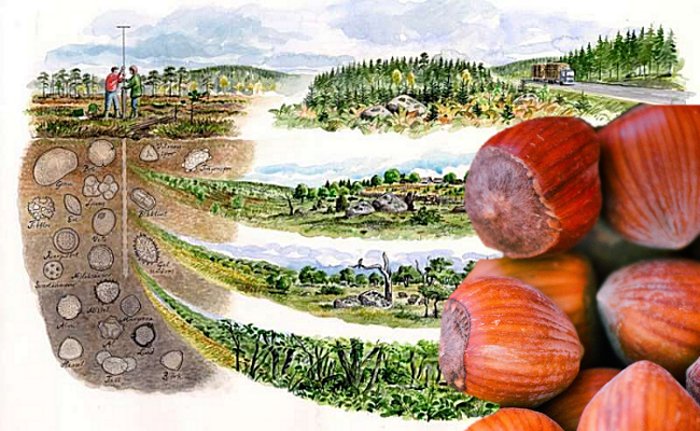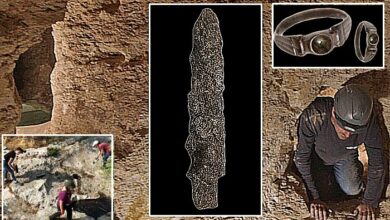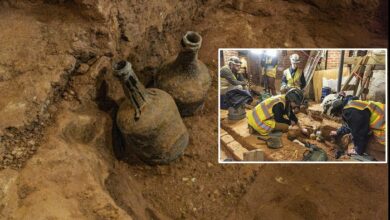Hazelnuts -‘Time Capsule’ To Reconstruct Landscape Of Ancient Forests In Sweden

Conny Waters – AncientPages.com – Since the early Holocene period, people in northern Europe have enjoyed hazelnuts, a powerful and easy-to-obtain energy source. Now, archaeologists can recreate ancient woodlands with the hazelnuts’ help.
An archaeologist takes samples of pollen found in soil to understand the changing vegetation of a site: a companion technique to the authors’ analysis of hazelnut shells. Credit: Nils Forshed, given to Dr Per Lagerås and shared with Dr Lagerås’s kind permission.
In a recent study, archaeologists have turned to examining the carbon isotopes in hazelnuts discovered at archaeological digs. These isotopes serve as a time capsule, offering insights into the environmental conditions of the past.
These isotopes serve as a time capsule, offering insights into the environmental conditions of the past. Interestingly, hazelnuts from dense forests exhibit different carbon isotopes than those grown in open, sunlit areas.
Using this data, are able to paint a picture of what human habitats looked like thousands of years ago.
Imagine if we could step back in time and witness the surroundings that our Mesolithic ancestors once inhabited. What sights would meet our eyes?
A new method of examining preserved hazelnut shells offers valuable insights into the nature of microhabitats surrounding archaeological sites, revealing if they were densely wooded or more open and pasture-like.
How did the local environment appear thousands of years ago, and what has been the impact of human activities on these habitats over time?
“By analyzing the carbon in hazelnuts recovered from archaeological sites in southern Sweden, from Mesolithic hunter-gatherer campsites through to one of the largest and richest Iron Age settlements in northern Europe, we show that hazelnuts were harvested from progressively more open environments,” said Dr Amy Styring of the University of Oxford, lead author of the article in Frontiers in Environmental Archaeology.
People in northern Europe have been using hazel trees as a valuable resource – for materials and food for thousands of years.
“The nuts are an excellent source of energy and protein, and they can be stored for long periods, consumed whole or ground,” Dr Karl Ljung of Lund University, Sweden, senior author of the article, said in a press release.
“The shells could also have been used as a fuel.”
Like all other plants, hazel trees are composed of carbon in various forms called isotopes. The balance between these different carbon isotopes can be influenced by the ratio of carbon dioxide levels inside leaf cells compared to the external environment.
Hazel trees are significantly impacted by sunlight and water availability. In places like Sweden, where water isn’t a limiting factor, sunlight plays a much bigger role in their growth. When there’s less competition from other trees for sunlight, hazel trees can photosynthesize more efficiently, resulting in higher carbon isotope values.
One can say that the more sun they get without fighting for it, the better they thrive.
“This means that a hazelnut shell recovered on an archaeological site provides a record of how open the environment was in which it was collected,” explained Ljung. “This in turn tells us more about the habitats in which people were foraging.”
After studying archaeological samples, the researchers discovered that nuts were primarily gathered from more enclosed habitats during the Mesolithic era. Later, nut collection shifted towards open environments.
By the Iron Age, it was evident that most hazelnuts used in this research came from open spaces, not forests.
“Our study has opened up new potential for directly tying environmental changes to people’s foraging activities and reconstructing the microhabitats that they exploited,” said Styring.
“We would like to directly radiocarbon date and measure the carbon isotopes of hazelnut shells from a wider range of archaeological sites and settings. This will provide much more detailed insight into woodlands and landscapes in the past, which will help archaeologists to better understand the impact of people on their environment, and perhaps help us to think differently about woodland use and change today.”
Written by Conny Waters – AncientPages.com Staff Writer





